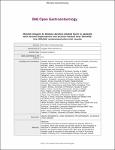Mental Imagery to Reduce Alcohol-related harm in patients with alcohol use disorder and alcohol-related liver damaGE: the MIRAGE randomised pilot trial results
| dc.contributor.author | Dhanda, A | |
| dc.contributor.author | Andrade, J | |
| dc.contributor.author | Allende, H | |
| dc.contributor.author | Allgar, V | |
| dc.contributor.author | Bailey, M | |
| dc.contributor.author | Callaghan, L | |
| dc.contributor.author | Cocking, L | |
| dc.contributor.author | Goodwin, E | |
| dc.contributor.author | Hawton, A | |
| dc.contributor.author | Hayward, C | |
| dc.contributor.author | Hudson, B | |
| dc.contributor.author | Ingram, W | |
| dc.contributor.author | Jeffery, A | |
| dc.contributor.author | King, A | |
| dc.contributor.author | Lavers, V | |
| dc.contributor.author | Lomax, J | |
| dc.contributor.author | McCune, CA | |
| dc.contributor.author | Musicha, C | |
| dc.contributor.author | Parker, R | |
| dc.contributor.author | Rollinson, C | |
| dc.contributor.author | Wilks, J | |
| dc.contributor.author | Creanor, ES | |
| dc.date.accessioned | 2024-02-06T11:08:11Z | |
| dc.date.available | 2024-02-06T11:08:11Z | |
| dc.date.issued | 2024-01 | |
| dc.identifier.issn | 2054-4774 | |
| dc.identifier.issn | 2054-4774 | |
| dc.identifier.other | e001267 | |
| dc.identifier.uri | https://pearl.plymouth.ac.uk/handle/10026.1/22031 | |
| dc.description.abstract |
Objective The healthcare burden of alcohol-related liver disease (ARLD) is increasing. ARLD and alcohol use disorder (AUD) is best managed by reduction or cessation of alcohol use, but effective treatments are lacking. We tested whether people with ARLD and AUD admitted to hospital could be recruited to and retained in a trial of Functional Imagery Training (FIT), a psychological therapy that uses mental imagery to reduce alcohol craving. We conducted a multicentre randomised pilot trial of treatment as usual (TAU) versus FIT+TAU in people admitted to hospital with ARLD and AUD. Design Participants were randomised to TAU (a single session of brief intervention) or FIT+TAU (TAU with one hospital-based FIT session then eight telephone sessions over 6 months). Pilot outcomes included recruitment rate and retention at day 180. Secondary outcomes included fidelity of FIT delivery, alcohol use, and severity of alcohol dependence. Results Fifty-four participants (mean age 49; 63% male) were recruited and randomised, 28 to TAU and 26 to FIT+TAU. The retention rate at day 180 was 43%. FIT was delivered adequately by most alcohol nurses. 50% of intervention participants completed FIT sessions 1 and 2. There were no differences in alcohol use or severity of alcohol dependence between treatment groups at day 180. Conclusion Participants with ARLD and AUD could be recruited to a trial of FIT versus FIT+TAU. However, retention at day 180 was suboptimal. Before conducting a definitive trial of FIT in this patient group, modifications in the intervention and recruitment/retention strategy must be tested. Trial registration number ISRCTN41353774. | |
| dc.format.extent | e001267-e001267 | |
| dc.format.medium | Electronic | |
| dc.language | en | |
| dc.publisher | BMJ | |
| dc.subject | HEALTH ECONOMICS | |
| dc.subject | LIVER CIRRHOSIS | |
| dc.subject | PSYCHOTHERAPY | |
| dc.subject | ALCOHOLIC LIVER DISEASE | |
| dc.title | Mental Imagery to Reduce Alcohol-related harm in patients with alcohol use disorder and alcohol-related liver damaGE: the MIRAGE randomised pilot trial results | |
| dc.type | journal-article | |
| dc.type | Article | |
| plymouth.author-url | https://www.ncbi.nlm.nih.gov/pubmed/38286518 | |
| plymouth.issue | 1 | |
| plymouth.volume | 11 | |
| plymouth.publication-status | Published | |
| plymouth.journal | BMJ Open Gastroenterology | |
| dc.identifier.doi | 10.1136/bmjgast-2023-001267 | |
| plymouth.organisational-group | |Plymouth | |
| plymouth.organisational-group | |Plymouth|Research Groups | |
| plymouth.organisational-group | |Plymouth|Research Groups|Centre for Brain, Cognition and Behaviour (CBCB) | |
| plymouth.organisational-group | |Plymouth|Research Groups|Centre for Brain, Cognition and Behaviour (CBCB)|Cognition | |
| plymouth.organisational-group | |Plymouth|Faculty of Health | |
| plymouth.organisational-group | |Plymouth|Faculty of Health|School of Psychology | |
| plymouth.organisational-group | |Plymouth|Research Groups|Institute of Health and Community | |
| plymouth.organisational-group | |Plymouth|REF 2021 Researchers by UoA | |
| plymouth.organisational-group | |Plymouth|Users by role | |
| plymouth.organisational-group | |Plymouth|Users by role|Academics | |
| plymouth.organisational-group | |Plymouth|REF 2021 Researchers by UoA|UoA01 Clinical Medicine | |
| plymouth.organisational-group | |Plymouth|REF 2021 Researchers by UoA|UoA04 Psychology, Psychiatry and Neuroscience | |
| plymouth.organisational-group | |Plymouth|Faculty of Health|Peninsula Medical School | |
| plymouth.organisational-group | |Plymouth|REF 2021 Researchers by UoA|UoA04 Psychology, Psychiatry and Neuroscience|UoA04 REF peer reviewers | |
| plymouth.organisational-group | |Plymouth|Admin Group - REF | |
| plymouth.organisational-group | |Plymouth|Admin Group - REF|REF Admin Group - FoH | |
| plymouth.organisational-group | |Plymouth|REF 2021 Researchers by UoA|UoA01 Clinical Medicine|UoA01 Clinical Medicine | |
| plymouth.organisational-group | |Plymouth|Research Groups|Plymouth Institute of Health and Care Research (PIHR) | |
| plymouth.organisational-group | |Plymouth|REF 2028 Researchers by UoA | |
| plymouth.organisational-group | |Plymouth|REF 2028 Researchers by UoA|UoA01 Clinical Medicine | |
| plymouth.organisational-group | |Plymouth|REF 2028 Researchers by UoA|UoA04 Psychology, Psychiatry and Neuroscience | |
| dc.publisher.place | England | |
| dcterms.dateAccepted | 2024-01-04 | |
| dc.date.updated | 2024-02-06T11:08:11Z | |
| dc.rights.embargodate | 2024-2-9 | |
| dc.identifier.eissn | 2054-4774 | |
| rioxxterms.versionofrecord | 10.1136/bmjgast-2023-001267 |


